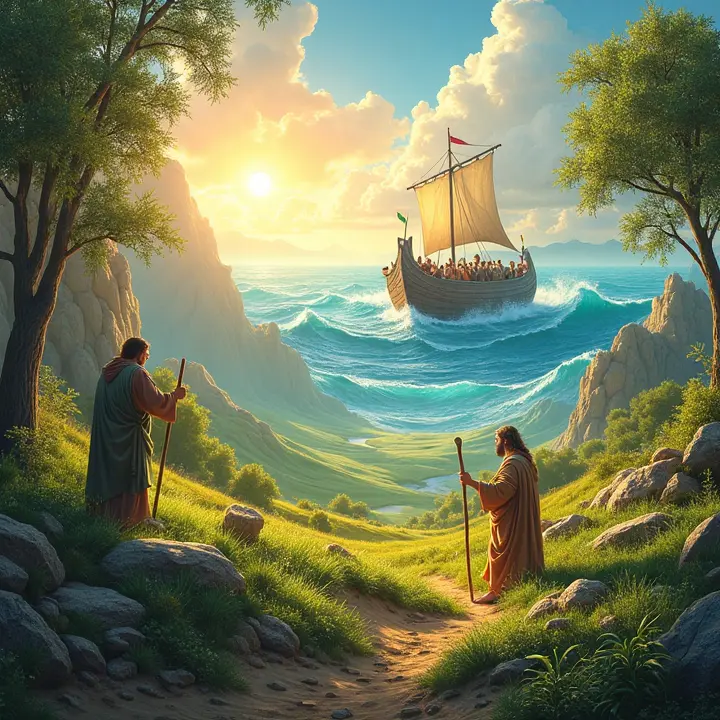The Bible, a sacred text that has been revered for centuries, is filled with stories that touch upon various aspects of life, spirituality, and the relationship between humans and the divine. Among these stories, nature plays a significant role, often serving as a backdrop, a symbol, or even a character in its own right. Nature stories in the Bible not only provide vivid imagery but also convey deep spiritual truths and moral lessons.
One of the most well-known nature stories in the Bible is the creation narrative found in the Book of Genesis. In this story, God creates the world in six days, and on each day, a different aspect of nature comes into being. On the first day, God creates light, separating it from darkness. This act of creation sets the stage for the rest of the week. On the second day, God creates the sky, dividing the waters above from the waters below. The third day sees the formation of dry land and the emergence of plants, each producing seeds according to its kind. The fourth day brings the sun, moon, and stars into existence, serving as markers for time and seasons. On the fifth day, God creates the creatures of the sea and the birds of the air, filling the skies and waters with life. Finally, on the sixth day, God creates the land animals and, most importantly, human beings, made in the image of God. This creation story highlights the beauty and diversity of nature, emphasizing that all living things are part of a grand design. It also establishes a sense of stewardship, as humans are given the responsibility to care for the earth and its inhabitants.
Another notable nature story is the story of Noah’s Ark. In this narrative, God decides to cleanse the earth of its wickedness through a great flood. Noah, a righteous man, is chosen by God to build an ark to save his family and a pair of every kind of animal. The story describes the construction of the ark, the gathering of the animals, and the forty days and nights of rain that cover the earth. After the floodwaters recede, Noah releases a dove to see if the waters have subsided. The dove returns with an olive leaf in its beak, symbolizing the presence of dry land and the beginning of a new start. This story illustrates the power of nature as a both force of destruction and renewal. It also emphasizes the importance of faith and obedience, as Noah’s actions save both humanity and the animal kingdom from extinction.
The story of Moses and the Israelites’ exodus from Egypt also contains significant nature elements. As the Israelites journey through the wilderness, they face numerous challenges, including a lack of water and food. In one instance, God provides water for the people by instructing Moses to strike a rock with his staff. Water gushes forth from the rock, quenching the Israelites’ thirst. This miracle demonstrates God’s ability to use nature to sustain and protect His people. Additionally, the story of the manna, a miraculous food that appears on the ground each morning, highlights the provision and care of God in the midst of a harsh and unforgiving environment. These nature-related events serve as reminders of God’s faithfulness and the importance of trusting in His guidance.
The New Testament also contains several nature stories that convey important messages. One such story is the feeding of the five thousand. Jesus, with only five loaves of bread and two fish, miraculously feeds a large crowd of people. This event takes place in a natural setting, with Jesus and the crowd gathered on a hillside. The abundance of food symbolizes God’s generosity and the ability to provide for His people’s needs, even in seemingly impossible circumstances. Another nature-related miracle is Jesus walking on water. This act demonstrates Jesus’ divine power and authority over nature, showing that He is not bound by the laws of the physical world. These stories in the New Testament emphasize the connection between Jesus and nature, as well as the spiritual significance of these events.
In the parables of Jesus, nature often serves as a metaphor to teach spiritual lessons. For example, in the parable of the sower, Jesus describes a farmer who scatters seed on different types of soil. The seed that falls on good soil grows and produces a bountiful harvest, while the seed that falls on rocky ground or among thorns fails to thrive. This parable uses the imagery of farming and nature to illustrate the importance of having a receptive heart to receive and understand the word of God. Similarly the, parable of the mustard seed compares the kingdom of God to a tiny seed that grows into a large tree, emphasizing the potential for great things to come from small beginnings. These parables use nature as a relatable and powerful tool to convey deeper spiritual.
truthsNature stories in the Bible are not just tales of the past; they continue to resonate with people today. They remind us of the beauty and complexity of the natural world, as well as our responsibility to care for it. stories These also highlight the interconnectedness of all living things and the presence of the divine in creation. Through the creation narrative, the story of Noah’s Ark, the exodus, and the teachings of Jesus, we see how nature serves as a backdrop for some of the most important moments in human history. These stories encourage us to appreciate the wonders of the natural world, to recognize the hand of God in creation, and to strive to live in harmony with the environment.

